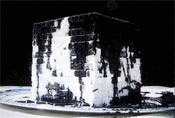Over the weekend, Mobile Art Production's group exhibition, "Defence," occupied Stockholm's Skeppsholmen and Kastellholmen. These islands formerly served as fortifications for the city but now primarily function as picnic grounds, a change that has led curator Magdalena Malm to consider both historical and contemporary defense systems, as well as the potential danger of forgetting or repressing a place's past entanglements with violence and military force. Such open reflection is further important, Malm claims, to curtail the type of profiling that has become one outgrowth of the shift, in our terroristic age, from external to personal, psychological defense: "If we previously held the belief that the armed forces would protect us, the responsibility has now been firmly placed on each and every one of us to be aware of empty bags and people behaving suspiciously." A stellar collection of artworks explored these variegated topics, including the video Testimony, Kutlug Ataman's study of Turkey's amnesia about its oppression of Armenians during World War I, manifest by his father's old wet-nurse's delusional, autobiographical recollection of that era. A composite of white sugar cubes turns black and melts beneath a stream of motor oil, in Kader Attia's video Oil and Sugar #2, a powerful, symbolic pairing of two materials that have each dictated East-West commerce. Henrik Andersson specifically addressed the exhibition's site with real-time recordings of the underwater area surrounding the islands, a reference to the alleged intrusion of Russian submarines, in the 1980s, into the Swedish territorial waters around the Stockholm archipelago. While political relations have shifted since this historical incident, Andersson's work acknowledges how the mere possibility of an external threat transforms listening into a process of detection, and every foreign, underwater sound into something suspicious. - Tyler Coburn
Image: Kader Attia, Oil and Sugar #2, 2007